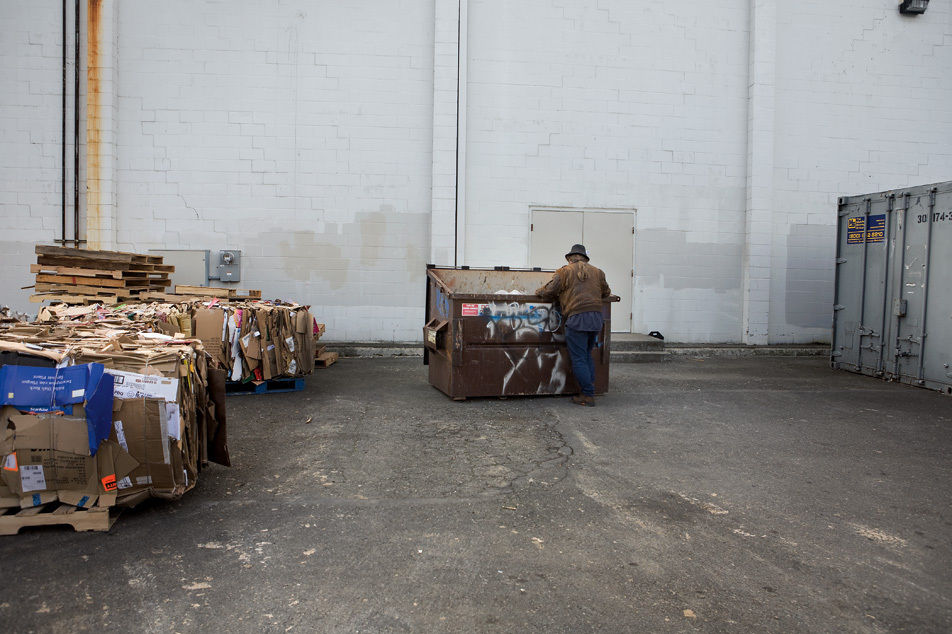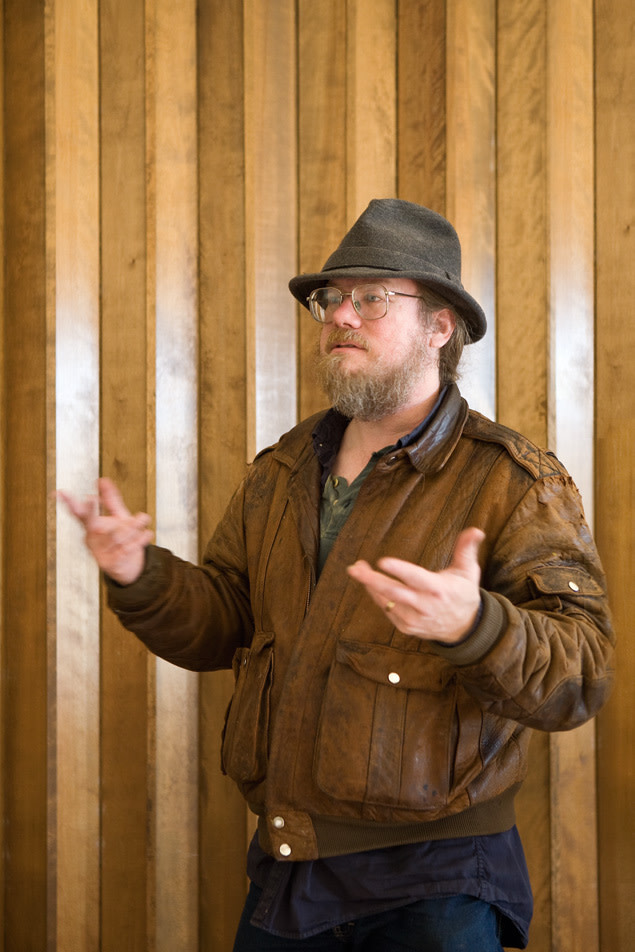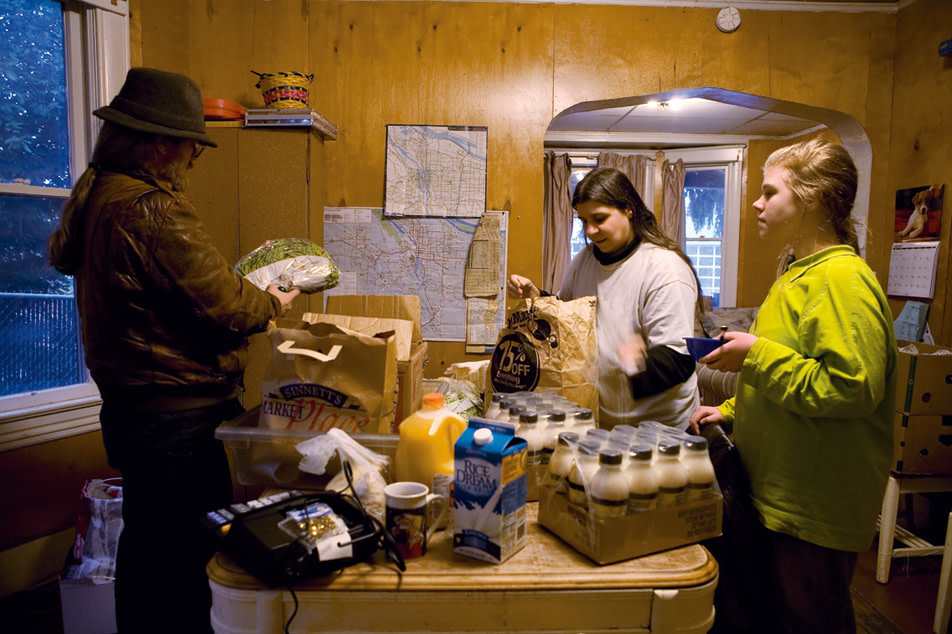
Holy Diver
SQUATTING IN THE BOTTOM OF AN INDUSTRIAL-SIZE DUMPSTER, Steve Kimes surveys the brown metal canyon rising up around him like he’s some Indian scout tracking buffalo on the Great Plains. He scans the rusty innards for anything edible, sniffs at the air for signs of rot, uses his foot to shuffle the debris around his ankles: every object is potentially usable, every piece of scrap a possible meal. Pink Floyd’s “Us and Them” ebbs and flows from his van, idling nearby, as Kimes snatches up a plastic bag of lettuce, gives it a smell, winces, then tosses it aside. Nope. Nasty.
A relic peeking out from under a bag of French bread ratchets him to attention. It’s small and chocolaty and glistens in its clear plastic packaging. And there are dozens of them. He looks up, a smile pieced together behind a wild bramble of red and gray beard. “Bakery day,” he says, like he’s just unearthed a fossil. “Yes!”
So in 1997, Kimes and his family cut ties with their life of steady food and shelter. They gave away whatever possessions they could and stored the rest in a barn next to their home church, then wandered into the unknown armed only with faith.
For the next eight months, Kimes slept on couches across Portland, sustained himself on the kindness of others, and ate what he could get by way of handouts or Dumpster dives. For four of those months he had his family in tow. “I needed to know what it was like to not have anywhere to go,” Kimes says now. “I had to know what it meant to truly be homeless.”
Then, galvanized by the experience, Kimes and his wife and their two kids quit their wandering and began piecing together what would become Anawim Christian Community.
First they found another apartment. Then they began hosting informal dinners for street people again. Then came a singular outreach effort at Peace Mennonite Church in Gresham. Kimes offered food, showers, and a clothing exchange. Ten years later, Anawim (the Hebrew word for “humble” or “poor”) has grown into a roving band of goodwill that, four times a week, provides food, clothing, showers, entertainment, and even jobs for hundreds of Portland-area homeless.
In a city with so many nonprofit bleeding hearts, urban ministries aren’t exactly unique, but Anawim’s approach is. It’s work you can’t do wearing a tie—you must be encrusted in the grimy marrow of the street. And judging by the battered state of his leather jacket, the dirt clinging to his gray felt hat, and the oniony smell that fills his van after a long day working to keep Anawim afloat, Kimes is.
Which brings us back to the Dumpster. As Kimes lifts himself out and over and onto a narrow metal ladder, he’s holding a dozen white roses. They’re a little brown at the petals, a little less fragrant than before, but still totally capable of wowing his wife.
Even in a pile of fetid crap, this man finds flowers.
There’s a lesson here somewhere.

Steve Kimes speaks to the congregation at Peace Mennonite Church
Image: Jenny Souza,Jenny Souza
THE TRUTH IS, when you see a homeless person holding a sign at an intersection, you hit the gas and send silent agonized prayers skyward, hoping the stoplight doesn’t catch you. Because if you have to stop, you’ll have to admit that there is another human being right outside the window, begging for help. And when you don’t roll down the window to offer a hand, you’ll be forced to feel guilty.
This, clearly, is a lot of work to do to avoid parting with a dollar or a handful of nickels.
Kimes’s solution is more direct: he rolls down his window and offers socks. “Clean socks are gold out on the streets,” he says, hailing a homeless man in camo and handing him white tube socks and an energy bar. Cruising up near the Rose Garden, with “Black Celebration” (Depeche Mode’s national anthem of goth) moping from the stereo, Kimes doles out Gold Toes and granola. It’s nearly more than a brain programmed to demarcate humanitarian and hip into non-intersecting columns can handle. Kimes relishes the dichotomy.
“This is our life,” he screams over Dave Gahan’s heroin whine. “We’re not plugged into the crumbling empire.”
He’s right, of course. And this, too, is a gift. Kimes is so driven by his desire to create this free-form utopia where the homeless gain self-sufficiency and the respect of the middle class while still keeping their eyes focused on the Lord that all shades of zealotry or general assholery in these types of comments are scoured away—even when he says things like “People with a high income have to give it away to get into heaven,” or preaches the perils of homosexuality in his sermons. His cause is just, his intentions righteous. Sometimes it’s better just to bite your tongue.
The man in the passenger seat, Mike DeSerio, knows all about the crumbling empire. He unplugged himself six months ago. He’d gone through a divorce. He hated his job. And he lived in Tampa, the glistening tit-tassel of Florida. Looking for inspiration, he sought direction from Google. He typed in the words “wilderness” and “Portland” and somehow found his way to one of Kimes’s many blogs. A Christian by trade, DeSerio was turned on by Kimes’s pro-service doctrine. He bought a one-way ticket and settled in on Kimes’s porch, where he slept for nearly three months until the weather got too cold.
Then he upgraded to the couch.
“I just felt the urge to be homeless, like God was telling me to do it,” DeSerio says, his imposing shaved head undercut by dorky black glasses. “So I came up and have sort of shadowed Steve to learn about the service he provides.”
In the ultimate sign of respect, Kimes—who runs in a world of grizzled men with handles like Ankles, Diver, Styxx, Slim, and Troll—gave DeSerio his very own nickname: Hammer. “We called him M.C. at first because he came from a middle class family,” Kimes explains, “but my wife said, ‘No, we should just call him Hammer. As in M.C. Hammer.’ We didn’t tell him why we named him Hammer for three months.”
With Hammer’s youthful muscle, Kimes’s three-pronged outreach has hummed of late. There’s the drive-by socking that goes into effect whenever Kimes is behind the wheel; there’s his home, which he opens to a rotating cast of homeless people, whose numbers would likely raise the ire of housing authorities; and then there are the four meals that Anawim serves weekly for upward of four hundred people.
Fridays are the most intense. Kimes and Hammer cover more than fifty miles in their rickety van, hitting up most every food pantry and Dumpster between Gresham and St. Johns in order to fill Anawim’s coffers.

Kimes and Styxx diving in Gresham
Image: Jenny Souza,Jenny Souza
The first stop is Peace Mennonite, where they drop off recycling and excess food from the house for the Saturday “shower” service. Inside, wearing tool belts and a couple of layers of drywall dust, stand two of Anawim’s true success stories: Ankles and Brian. When the pipes at Peace burst in December, the water took out walls and ceilings throughout the structure. The church was looking at a massive repair bill until the two men, homeless for years, offered their construction experience in exchange for housing and a small stipend. The solution saves Peace around $5,000 in labor, gives Brian and Ankles some dough and a place to stay for a few months, and buys Kimes some goodwill from the more conservative members of Peace, who still view the street ministry as a handout. “This is what I’m talking about,” Kimes says. “All Brian and Ankles needed was a hand up. People who say the homeless are lazy have never met one before.”
From Peace, he heads to a nearby apartment complex, where leftover frozen entrées are donated from the back of a Maria’s Catering truck. Then it’s over to the Zarephath pantry (where Kimes will have to break up a knife fight over a dog the next week) to pick up bread before switching to stealth mode for some Dumpster diving.
An aficionado by repetition, he hits the usual hot spots. He even finds a couple of floor mats in a Rite Aid Dumpster. “Diver introduced me to the diving thing,” Kimes says, leaning over the lip of a smaller metal bin to scoop out discarded dog food with a Taco Bell cup. “It’s almost mystical with him—you need it, he can find it. But it’s also a Mennonite trait. We’re known to be really frugal people. I talk to older men and they’re happy that I’m continuing the tradition.”
The van filled with whatever he can salvage, he heads toward St. Johns. Skirting the edge of Forest Park, Kimes points to paths notched into the woods where a rarely seen subset of the homeless are known to venture in and out under cover of darkness. “Regular street people are scared of the ones who live in Forest Park,” he says. “It’s weird.”
Since the Wesleyan Church in St. Johns serves more kids, and since Kimes caters mostly to adults, he swaps out children’s books and clothes for another box full of bread, bags of vegetables, and even tubs of ice cream donated by Baskin-Robbins. The brown Toyota with the broken back door is now fully loaded down with food from four Dumpsters, three pantries, and one stop at the grocery store. Kimes checks his watch. Five o’clock. One hour until the doors open for the Friday meal at Sunnyside Methodist. He flips on the Alan Parsons Project’s “Eye in the Sky” and revs the dusty old van. It starts to shimmy just a bit.
One hundred and thirty people with empty bellies are counting on him to be on time.
“We’ve already passed five camps on our route,” Kimes says. He’s midway through another Friday food run, exhaling the information. “They’re just really well hidden. It’s like The Matrix.”
“No,” Hammer says, “it’s like when Han Solo was in the asteroid belt but he was actually inside that giant space worm so nobody knew he was in the asteroid belt.”

Parishioners crash on the couch at Peace Mennonite Church
Image: Jenny Souza,Jenny Souza
Geek analogies aside, the point is that of the nearly three thousand homeless people in the Portland area, many have found shelter off the grid, in the plentiful wilderness around the city. Kimes knows most of the hidden living quarters between Gresham and Portland, and after a little prodding from Hammer he finally agrees to show one he sincerely hopes is empty.
Kimes parks the car in a factory lot and, with Hammer trailing him at a safe distance, walks into the woods a quarter of a mile. “Don’t come here without me,” he says in a firm whisper. “It’s not safe. It’s not that they’re dangerous, but how would you like it if somebody came into your house? It’s the same thing with these guys.” After crossing a pair of train tracks, he stands under an overpass in what for all intents and purposes is somebody’s den. There are two tents, an oil drum fashioned into a grill, a few coffee mugs, cans of tuna and soup, and, to keep the area clean, a rake.
Once he’s relatively sure nobody’s home, Kimes finally speaks. It’s a trust thing—if he starts bringing strangers around camps like these, he might lose credibility. The campers tend to be wary of people with notepads, badges, or ties.
And why not? Kimes says it’s become common practice for Gresham police to throw away any signs of homeless encampments. Tents, sleeping bags, chairs, cans, mugs—basically all of their worldly possessions, tossed. “Las Vegas has a law where you can’t give street people food, and now we have a city camping ordinance in Portland, which basically makes it illegal to be homeless,” Kimes says. “I don’t see street people as a problem; I see them as a community that has been neglected. The problem is the people who don’t see that. Every politician, every judge, every member of the church—they need to spend time on the street. These people are considered the lowest of the low, completely outside of our mind-set.”
Kimes knows that what he’s saying sounds like the high-minded raving of a man who can see only to the far end of his own insular cause. But he doesn’t care. He is zealous, not stupid. “Do I think I can beat poverty? No way. But this whole ‘pull yourself up by the bootstraps’ thing is not the solution. They need help that treats them as adults.”
Anawim’s goal is twofold: to help the homeless act as Christians while they’re on the street, and to create bridges between the middle and lower classes. “Salvation is not some spiritual fantasy,” Kimes says. “It’s God meeting people’s needs by giving them sufficient resources for everybody. You just have to trust in God.”

The Kimes family sorts through the latest Dumpster and pantry haul
Image: Jenny Souza,Jenny Souza
As proof, he points to himself. When he needs food he goes diving—and finds fifty pounds of frozen meat. When he needs a van, a family moves to England and donates theirs. When the electric is about to get shut off at his house, the charity box fills up. People he hasn’t seen in years show up at his door to hand him $200.
Anawim’s next amazing feat will be to try and get a grant from the Mennonite Central Committee. The money would go toward setting up a business in which employers could hire street people for landscaping or recycling jobs, allowing them to earn their keep and take care of themselves. Considering Kimes’s worldview, such an operation would truly be a miracle. He sees street people as being closer in spirit to the life of Christ. In his world, the line in Jesus’s Sermon on the Plain that says “Blessed are the poor, for theirs is the kingdom of God” is far more than an allusion, it’s a mandate: “To me it means people with a high income have to give it away to get into heaven.”
How this goes over with the Central Committee, an organization that has never committed large funds to homeless outreach, depends on its members’ reaction to Kimes. “I am a hornet,” he says, stifling a giggle. “I’m stinging people in the right direction.”
A steady flow of name-brand foot traffic on a Tuesday night on a suddenly popular block of N Williams Avenue. Ten years ago, this was as close as Portland got to a “slum.” Crack deals went down on the corner. Busted-out glass littered the pavement. But for now, this strip is breaking out with the kinds of businesses that make the spines of the city’s upwardly mobile tingle: two new restaurants, a minimalist coffee shop, a yoga studio, a home-interior store.
In the shadows of a Victorian house, there is something else: a sign that looks like an abandoned historical marker. “Stop Hobophobia,” it reads. Inside the six-bedroom home lies the chaotic heart of Anawim.
Technically, Kimes is only a part owner of the house. His father bought it through the family trust at a ridiculously reduced price (the former owner was equally enamored of altruism). Inside, Kimes’s wife, Diane, fights a Sisyphean battle to maintain order in a home that has become more of a weigh station for Anawim’s do-goodery. This being Tuesday, Kimes is gearing up for Anawim’s weekly service at the dingy gymnasium inside the Cathedral of Praise just off SE Hawthorne, which he’s dubbed the “Yellow Church.” In addition to offering a meal and boxes of clothing, tonight they’re showing a movie, Horton Hears a Who. All of this has turned the family’s kitchen into a loading dock of bagged fruits and vegetables, tins of coffee, boxes of frozen apple fries, and dozens of loaves of bread piled into pyramids.
Often, though, the clutter inside the Kimes house is of the living and breathing variety. Kimes asked that the official number of residents not be printed, but with two converted toolsheds out back, extra bedrooms in the basement, a spare room on the main floor, various couches, and (during the summer) the front porch all in use, the house better resembles a commune. There is the occasional lice outbreak, but usually the close-quarters cohabitation runs smoothly.
Kimes’s children live here, too, of course. Diane and Steve split home-schooling duties for Ian, sixteen; Nikki, thirteen; and Mercy, eight. In turn, the kids help with the cleaning and general spirit of all-for-oneness that comes from sharing your home with a rotating cast of strangers. There are fringe benefits: Nikki and Mercy get first dibs on Dumpster hauls, which sometimes turn up off-brand Mexican Twinkies.
All non-family residents are homeless, and all stay for free. But there are rules. No visitors. No drugs or alcohol, and boarders must volunteer at least ten hours a week for Anawim.

Styxx
Image: Jenny Souza,Jenny Souza
Currently, the house on Williams includes a down-on-his-luck traveling musician and his family, a transgender man with multiple personality disorder, and a former meth addict who goes by the name Styxx.
With his ever-present aviator sunglasses and mustache, Styxx looks like some badass hybrid of Burt Reynolds and Steve Earle. He is a touch antisocial. When Kimes drops by his room in one of the converted sheds, Styxx screws the volume knob on his stereo so hard that Hendrix’s “Voodoo Chile” nearly blows Kimes out the door. Kimes blames the long-term meth use.
“Styxx,” he sighs. “Not exactly a people person.”
Tonight at the Yellow Church, Styxx is in charge of the audio-visual portion of the program. Music is his thing. Riding shotgun in the van, he takes over the stereo and pummels everyone with Led Zeppelin. On the way he growls excitedly about the time he landed the sweet speakers now housed in his apartment (“Speakers for tweakers, man,” he barks, “speakers for tweakers.”).
Kimes stops at Fred Meyer for microwavable bowls. In the checkout line, the magazine rack is filled with the likes of People and Us, airbrushed photos of John Travolta and his dead son on the covers. “Tragedy,” the headlines scream. On TV, Mayor Sam Adams is explaining his indiscretion. But empty pop-culture hand-wringing is not only worthless to the five folks in aisle twelve, it’s not even within their realm of reality. Socks. Soup. Hot coffee. These are the only currencies that matter.
At the church, Nikki and Mercy start setting up folding tables and chairs. An hour later, the Anawim congregation begins shuffling in. They’re greeted by the aroma of chicken tortilla soup and warm bread spilling from the kitchen, the sound of Jimmy Page’s satanic fret-work, and a slide show that Kimes has created of trippy Escher-meets-Bilbo-Baggins-style art in which feet morph into tree roots.
Kimes is a whirlwind of empathy. He shakes hands with friends who haven’t bathed in weeks. He hugs people who smell of urine. He passes out hand warmers. When a mentally ill man named Al becomes agitated and stomps away angrily, Kimes keeps after him: “We care, Al,” he yells after him. “We’re always here.”
With everyone finally fed, the lights go down. Thirty grizzled homeless men and women who have withstood some of life’s worst punishments settle into the dark—bellies full, bodies warm—to laugh at the misadventures of an animated elephant voiced by Jim Carrey. A man who looks like Charlie Manson starts chanting, “Horton, Horton … ”
Kimes slips into the back of the room and slumps onto a hard wooden pew. This is the burgeoning community of his dreams, realized in miniature: a self-sufficient operation that relies on hard work, interdependency, and a little luck to get by. For the first time in hours, he lets himself relax.




